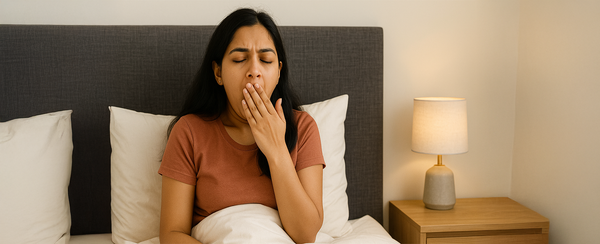What Your Body Is Trying to Tell You Through Pain

Table of Contents
What Your Body Is Trying to Tell You Through Pain
The Science of Pain: Explained
Common Ways Your Body Communicates Through Pain
Listening to Your Body: Practical Steps
The Role of Rest, Recovery & Sleep
From Pain to Awareness
What Your Body Is Trying to Tell You Through Pain
In ancient Ayurvedic practice, pain was perceived as the body’s essential warning sign. The human system was believed to be governed by three doshas — vata, pitta, and kapha — each representing movement, metabolism, and stability.
Pain, particularly joint or nerve pain, was often attributed to an excess of vata, the air element. When vata went out of balance, energy no longer flowed smoothly through the body’s channels (srotas), leading to stiffness, soreness, or fatigue.
It was observed on physical, moral, and spiritual planes, believed to be triggered by emotions, stress, and past karma. Healing was holistic, meant to restore your body’s natural balance through massage, herbal oils, meditation, and yoga.

Some of these ancient principles weren’t too far off the mark. Modern pain neuroscience mirrors this view — chronic pain today is known to intensify with emotional distress and poor nervous system regulation.
The Science of Pain: Explained
Pain begins with a trigger — an injury, strain, inflammation, or even prolonged poor posture. But it isn’t actually felt at the site of injury, it’s interpreted by the brain. Here’s how the process works:
- Detection (Nociception): Nociceptors (specialised nerve endings) detect potential harm and convert it into an electrical signal.
- Transmission: The electrical signal travels through peripheral nerves to the spinal cord via A-delta fibres (sharp pain) and C fibres (dull pain).
- Processing in the Spinal Cord: The signal is filtered and can be amplified or muted.
- Perception in the Brain: The signal reaches the thalamus, then different brain regions identify the location of the pain, assign emotion, and determine your reaction to it.
- Response: The brain sends signals back down to the body to trigger actions like muscle tensing, releasing stress hormones, or prompting movement.
Common Ways Your Body Communicates Through Pain
Chronic pain is now a global epidemic. According to The Lancet Public Health, over 1 in 5 adults worldwide live with chronic pain that lasts longer than 3 months.
It's interesting to note that stress and pain share the same neural pathway. Both trigger the hypothalamic-pituitary-adrenal (HPA) axis, which means that chronic stress keeps your pain active.

Lack of movement can actually alter your pain perception. Today's sedentary lifestyles have a big role to play here — 9-5 desk jobs, long commutes, extended periods looking down at a device — these habits might seem innocuous, but can actually make your brain more sensitive to pain signals.
Here are some common ways your body may signal pain:
- Neck and shoulder pain: Caused by tension from poor posture, screen time, or unsupportive pillows.
- Lower back pain: From sedentary habits, weak core, or lack of lumbar/spinal support while sleeping or seated.
- Joint stiffness: Arises through dehydration, poor circulation, or lack of movement.
- Morning aches: From poor sleep posture or wrong mattress/pillow firmness.
- Headaches or eye strain: Stress overload or misalignment in the cervical spine.
Listening to Your Body: Practical Steps
Pain perception is more than physical; it involves several steps of neurological and emotional processing. That’s why stress, poor sleep, and anxiety can exacerbate pain signals, because they make the nervous system more sensitive. Conversely, relaxation, good posture, deep sleep, and supportive mattresses and pillows can help dampen those signals. Here are some steps to keep in mind:
- Don't medicate until absolutely necessary. First try gentle stretches, hydration, or posture checks.
- Maintain mobility. If your daily routines involve long desk hours, remember to stretch your legs every 20 minutes.
- Track your pain and keep a note of when/where it occurs — patterns reveal causes.
- Prioritize recovery tools; ergonomic pillows, supportive mattresses, and mindful rest make a difference.
- Take steps to de-stress. According to Harvard Medical School, meditation can physically shrink pain-processing areas in the brain. Stress and pain go hand in hand; relaxation practices reduce sensitivity.
The Role of Rest, Recovery & Sleep
It undergoes crucial recovery processes that allow your body’s pain regulatory systems to function effectively.
First off, it regulates and balances your hormones and neurotransmitters. Deep sleep promotes the production of anti-inflammatory cytokines, which reduces inflammation in muscles and joints — a key source of chronic pain. It balances your hormones by increasing the secretion of the growth hormone which is vital for tissue repair, and also regeneration of muscle fibers and connective tissues.
At the same time, cortisol levels (the body’s stress hormone) drop during the early stages of sleep, reducing the impact of stress on your pain (since they share a common axis, the HPA). It also maintains optimal levels of dopamine and serotonin, the "happy hormones", which affect both your mood and pain regulation. Low levels heighten pain perception.
Deep sleep also regulates the pain-inhibitory pathways, which is basically your brain's pain control system. Lack of sleep weakens these mechanisms, which increases your nervous system's sensitivity to pain stimuli. During rest, “rest-and-digest” mode takes centre stage, leading to reducing muscle tension, heart rate, and stress responses — all of which contribute to lowering pain perception.

From Pain to Awareness
Sleep is an active part of the healing process, as crucial to recovery as medication or diet. It acts as a biological reset, restoring hormonal, neural, and inflammatory balance. When you sleep right, it’s half the battle fought.











